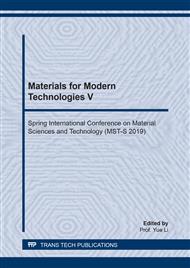[1]
Jiang Zhengwu, Sun Zhenping and Wang Xinyou. The Techniques of Conductive Concrete [J]. Concrete, 2000, 131 (9): 55-58.
Google Scholar
[2]
Zhou Yongxiang, Leng Faguang, He Gengxin and Ji Xiankun. An Overview on Conductive Concrete Technology [J]. China Building Materials Science & Technology, 2009, 131 (1): 42-50.
Google Scholar
[3]
Li Deshan, Jiang Hua and Yin Lixin. An Observation and Analysis on the Micromorphology and Microstructure of a Flake Graphite Using TEM and SEM [J]. Casting, 1996(2):9-13.
Google Scholar
[4]
Wen yahui, Chen Wenge and Hou Lintao. High Resolution Microstructure Analysis of Graphite Materials [J]. Journal of Chinese Electron Microscopy Society, 2015(3):189-194.
Google Scholar
[5]
Shen Gang and Dong Faqin. Study on Graphite Conductive Concrete [J]. Concrete, 2004, 172 (2): 21-62.
Google Scholar
[6]
Xie Yunfeng, Wang Yatao and Li Shunchang. Progress and Developing Status of Carbon Fiber Technology [J]. New Chemical Materials, 2013, 41(5):25-27.
Google Scholar
[7]
Cheng Jing. Study on PAN-based Carbon Fiber Conductive Asphalt Concrete [D]. Changsha: Highway & Railway Engineering of Changsha University of Science and Technology, (2010).
Google Scholar
[8]
Xie Ping, Gu Ping, Beaudoin J J.Electrical percolation phenomena in cement composistes containing condictuve fibres [J]. Journal of Materials Science, 1996, 31 (15):4093-4097.
DOI: 10.1007/bf00352673
Google Scholar
[9]
Wen S, Chung D D L. Seebeck effect in carbon fiber-reinforced cement[J]. Cement & Concrete Research, 1999, 29(12):1989–(1993).
DOI: 10.1016/s0008-8846(99)00185-4
Google Scholar
[10]
Hou Zuofu, Li Zhuoqiu and Hu Shengliang. Research on Electrical Resistance Variations of Carbon Fiber Conductive Concrete for Deicing or Snow Melting [J]. Concrete, 2004, 173 (3):3-21.
Google Scholar
[11]
Shen Gang and Dong Faqin. Study on Compositive and Electro- conductive Concrete [J]. China Concrete and Cement Products, 2003, 6:38-43.
Google Scholar
[12]
Rebecea Lylln Fitzgerald. Novel Application of Carbon Fiber for Hot Mix Asphalt Reinforcement and Carbon-Carbon Pre-forms [D]. USA: Michigan Technology University, (2000).
Google Scholar
[13]
Mo Juan, Fang Zhenggang and Xue Feng et al. Research on Microstructure of Conductive Concrete [J]. Journal of Chinese Electron Microscopy Society 2017,36(5):471-475.
Google Scholar
[14]
Song Kai, Gao Peiwei and Sun Yafei et al. Research on Mechanical Performance and Flexural Agility of Graphite-carbon Fiber Conductive Concrete [J]. China Concrete and Cement Products, 2016(12):1-5.
Google Scholar
[15]
Fang Zhenggang, Huang Peng and Xue Feng et al. Effects of the Mixing Amount of Graphite and Carbon Fiber on Macro Properties of Concrete [J]. Building Structure, 2017, 47(21): 59-62.
Google Scholar
[16]
Wang Qiang, Li Mengyuan and Shi Xiaomeng. Hydration Properties of Cement-Steel Slag-Ground Granulated Blast Furnace Slag Complex Binder [J]. Journal of Chinese Ceramic Society, 2014, 42(05): 629-634.
Google Scholar


